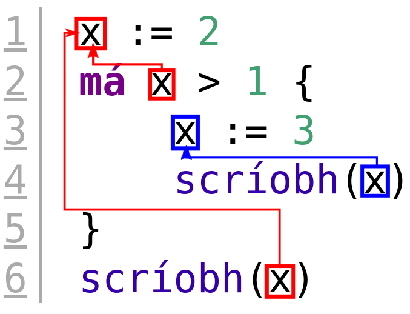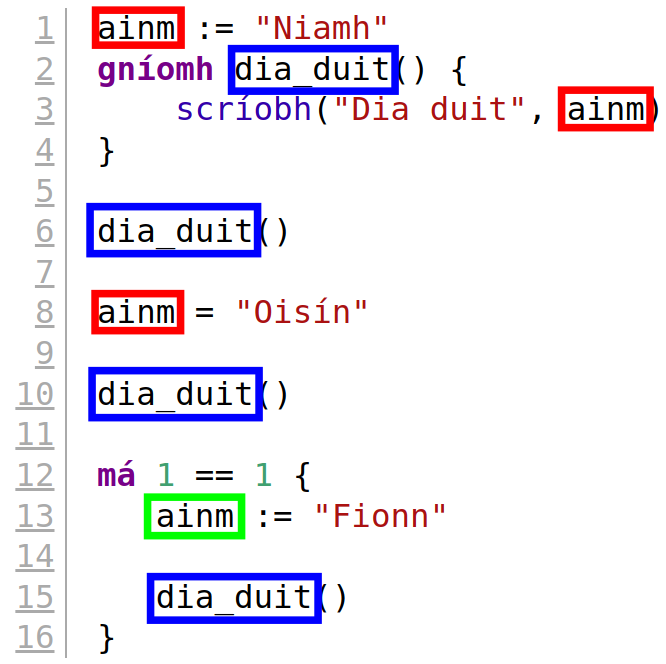- Tutorial Introduction
- What is programming?
- Take the Stage!
- It's decision time
- Lists 'n Loops
- In the Loop
- Time for Action
- Some Useful Actions
- Game Time!
- Let's Paint
- Outlines
- Scope
Scope
Spot the Difference
Think about this program, what does it write?
Try it out now, were you right?
Now look at this program: there is a very small difference between it and the previous program. Think again about what it prints.
Try it out again:
Were you right?
The first program printed “3” and “3”, but the second program printed “3” and “2”. What is the difference between them?
Notice the third line in both programs:
- The first program:
x = 3. - The second program:
x := 3.
As you know, := creates a new variable and = puts a new value in some variable. This is the difference between the two programs.
More Details
Lets look again at the first program:
The
- A variable
x := 2is created on the first line. - The expression
x > 1is true so the code in themáblock is run. - The line
x = 3changes the value ofxto3. - The next line writes the variable
x, which equals3, on the console. - Then the last line writes
xagain.
Now let’s look at the second program:
- A variable
x := 2is created on the first line. - The expression
x > 1is true so the code in themáblock is run. - A new variable
x := 3is created. - Next the line
scríobh(x)is run, but what doesxmean here? We have two variables calledx. When we ran the program earlier it printed “3”, soxmust mean the second variable, the one that is defined in themáblock. scríobh(x)is the last line too, what doesxmean here? If you run the program this line will print “2”: Thisxmust mean thexon the first line.

What is happening here?
What is Scope ?
When you create a variable, what are the places in the program you can use that variable? We call these places the
For example, look at this code:
We can use the variable country on line 3 because line 3 comes after line 2. The following program is not correct because we cannot use the variable before we use it.
Things get more complex when we use má, le idir, nuair-a and actions.
Look at this code:
Is that code correct? It’s not; The scope of x is limited; When you create a variable in a block of code (code between { and }) you cannot use that variable from the outside. However, you can use it in any blocks that are
These
ainm := "Niamh"
gníomh dia_duit() {
scríobh("Dia duit", ainm)
}
dia_duit()
ainm = "Oisín"
dia_duit()
má 1 == 1 {
ainm := "Fionn"
dia_duit()
}Try it out!
Were you correct? The line ainm = "Oisín" worked, but the line ainm := "Fionn" didn’t do anything. This happens because the ainm variable in the body of dia_duit is in the scope of the first variable ainm, and the line ainm := "Fionn" creates a different variable with a different scope: It has no effect.
In this picture each ainm variable isn’t used anywhere.

Shadowing
What happens when we create 2 variables with the same name? We saw this already in the program at the top of the page:
The 4th line (scríobh(x)) looks like it’s in the scope of both x variables; The one on the first line and the one on the third line. In this case it uses
It’s as if the second variable
However: in general it is bad practice to create a variable that hides another variable. You should use a unique name for each variable: Things get
NB: You cannot create a new variable with a name that is already in use in the same block. For example, the following code does not work:
Recursion
An action can call itself, we call this process
When write_number(10) is called, it writes “10” on the console, it then checks if 10 is greater than 1, which of course it is so it calls write_number(9). This writes “9” and then calls write_number(8), then that calls write_number(7), write_number(6) until it reaches write_number(1). At that point x > 1 is not true anymore so it stops.
If a variable is created in the action, a unique version of this variable is created every time the action is called.
When we call f(2) it creates a new variable y that is equal to 2. Then it checks if x > 1 which it is. Then it calls f(1). A new variable is created call y that is equal to 1, this variable is different from the variable y we created earlier. 1 is not greater than 1 so we do not call f(0). Instead we write y on the console, which writes “1”. Now we go back to the previous call f(2) and we continue on. scríobh(y) is the next line, but y is not equal to 1 here, it’s equal to 2 because this refers to the first y we created, not the second. This then writes “2” on the console.
The Global Scope
Setanta has one special scope, x, mo_ghníomh and MoChreatlach in the following program have global scope. However, the variable áitiúil does not.
creatlach MoChreatlach {
gníomh ainm() {
scríobh("Setanta")
}
}
gníomh mo_ghníomh() {
áitiúil := "Dia duit"
toradh áitiúil
}
x := 3Global variables are special, because we can use them before we create them when we use them in an action. Lets look at some examples:
This code works: Try it out!
Code like this only works in the global scope, for example, code like this does not work. If you run it you will get an error:
We can use this to create two actions like this: This pair of actions is a bit strange, they do work but it is worth explaining how.
gníomh number_is_even(x) {
má x == 0 {
toradh fíor
}
toradh number_is_odd(x - 1)
}
gníomh number_is_odd(x) {
má x == 0 {
toradh bréag
}
toradh number_is_even(x - 1)
}The action number_is_odd calls number_is_even and the action number_is_even calls number_is_odd. This works because number_is_even can number_is_odd
More Setanta
All there is to do now is to go to the editor and try out the language. There are some examples and more documentation available on docs.try-setanta.ie.
If you need any information, or if you have any problems, you can send an email to help@try-setanta.ie.